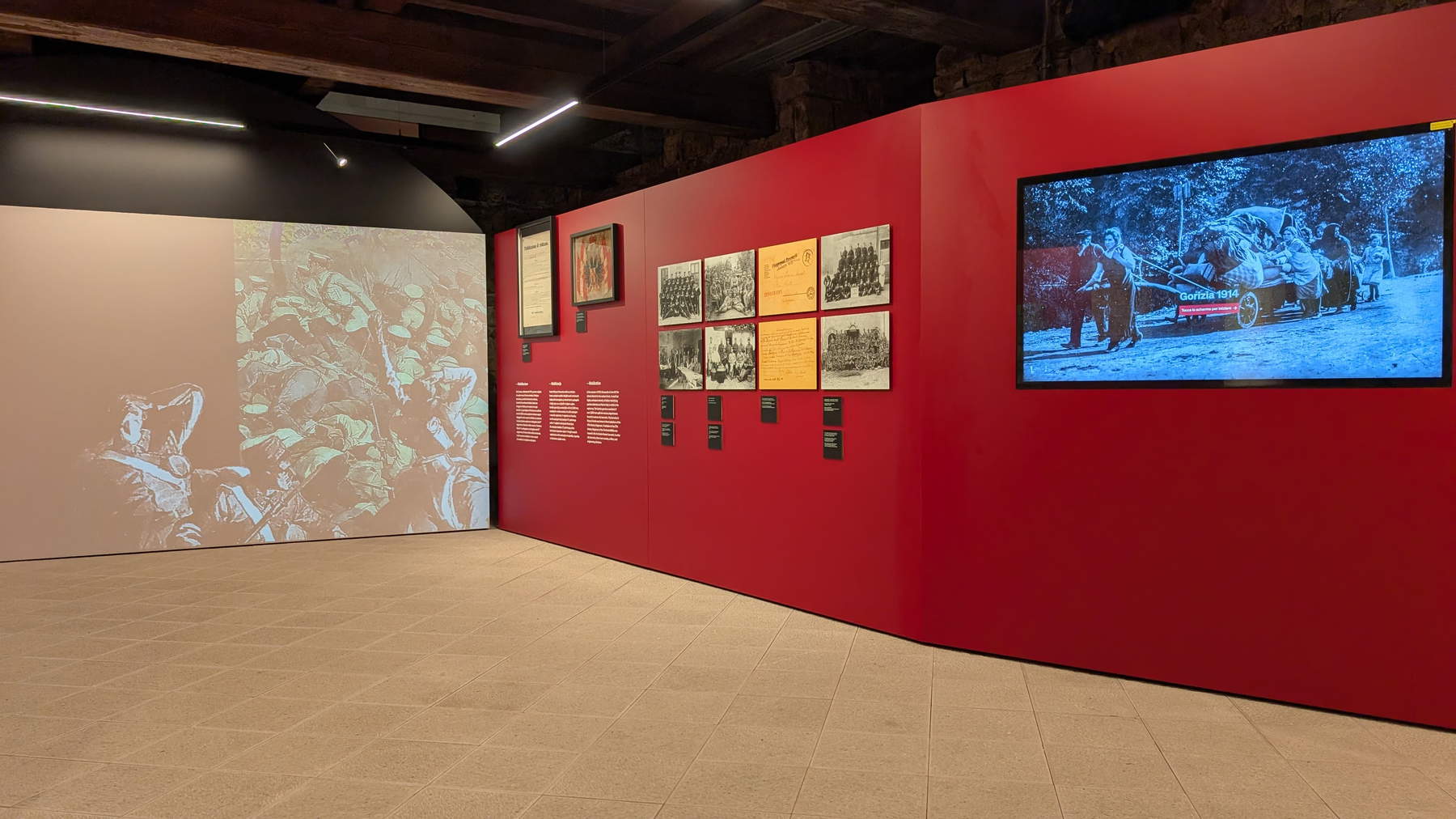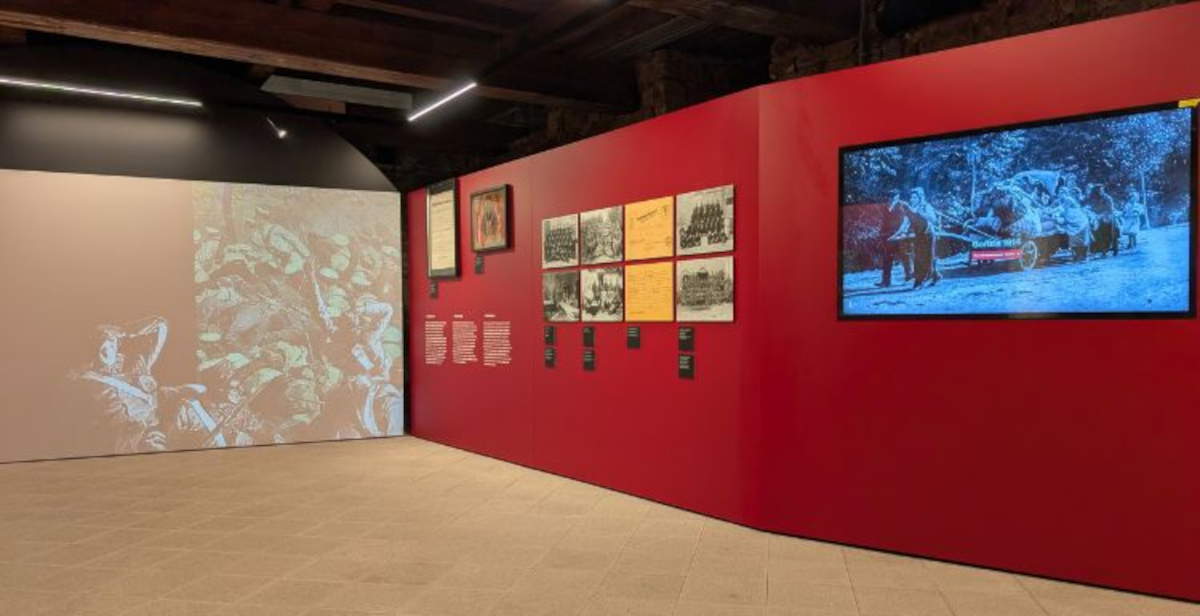The Great War Museum in Gorizia reopened to the public on Thursday, July 17, after an articulated structural and museographic redevelopment involving the entire exhibition itinerary. The initiative is part of the GO! 2025 program linked to Nova Gorica - Gorizia European Capital of Culture, and is part of the project to enhance the Provincial Museums of Borgo Castello, managed since 2016 by Erpac FVG.
The new exhibit, curated by Alessandra Martina and Lucio Fabi, offers a ten-room itinerary that traces the everyday life of World War I, with a focus on the experiences of Italian and Austro-Hungarian soldiers at the front and the civilian population in the territories involved in the conflict. On display are uniforms, armaments, ammunition, documents and photographs, distributed in a thematic itinerary that takes the visitor through the phases and transformations of the first great twentieth-century conflict.
The project develops and renews concepts introduced in 1990 at the time of the opening of the Museum, whose approach to the narrative of the war was innovative at the time, shifting the focus from the strictly military dimension to the human and everyday dimensions of the conflict. Maria Masau Dan’s direction was joined on that occasion by Antonio Sema, a scholar of military history who died in 2007, and Lucio Fabi himself, who is now again involved in the curatorship.
A central element of the new exhibit is the diorama of the battlefield, renovated and enhanced with multimedia technologies designed by IKON, a company specializing in designing immersive digital environments. From the entrance, visitors are accompanied by interactive stations that introduce the historical context of prewar and 1914 Gorizia. An initial video guides the transition from the Belle Époque to the outbreak of conflict, providing an accessible and effective introduction.
Each room is accompanied by trilingual descriptive apparatus, Italian, Slovenian and English, developed according to the Ministry of Culture’s guidelines for museum communication. The texts are concise, written in clear language and supported by a graphic layout that makes them easy to read. The graphic design of the layout was entrusted to Roberto Duse diobliquestudio.

The last room is dedicated to the theme of remembrance and offers a look at the monuments and shrines built after the war, emphasizing the ways in which the conflict was represented and commemorated in the years that followed. The theme of war narrative and memory will be further developed by Erpac through a series of lectures and cultural initiatives planned in the coming months.
In addition to the historical-exhibit narrative, the new museum also stands out for its structural interventions in terms of accessibility. The route has been made accessible to all types of audiences thanks to the introduction of ramps, platforms, elevators, elevating platforms and stair lifts, as well as new access and a specially designed lighting system. The interventions also include plant upgrades to the entire complex, with the inclusion of a data network useful for both home automation management of the Museum Complex and multimedia installations, as well as video surveillance, intrusion and fire prevention systems.
During work on the construction of an external elevator and ramp in the garden connecting the various buildings of the Borgo Castello Provincial Museums, significant archaeological finds also emerged. Currently under study by the Superintendence of Archaeology, Fine Arts and Landscape of Friuli Venezia Giulia, the materials could help rewrite some of the historical phases of the settlements in the Borgo Goriziano.
A section on the Gorizia area in the early 20th century and in 1914 has also been integrated within the museum itinerary, with a room dedicated to the destruction suffered by Gorizia during the conflict. A multimedia table illustrates the effects of bombing and urban warfare on a city that for about thirty months was on the front line and suffered extensive damage from both sides in the war.
The construction site that affected the Great War Museum also involved the spaces of the Museum of Fashion and Applied Arts and Casa Morassi. The total investment for this tranche of work exceeds 2,500,000 euros, out of a total planned economic framework of 4,862,666.67 euros. The project was able to count on PNRR co-financing, obtained thanks to the candidacy of the proposal A Thousand Years of History at the Center of Europe: Borgo Castello crossroads of peoples and cultures, within the Borghi investment line.
The design and direction of the work was entrusted to the temporary grouping of Politecnica Ingegneria e Architettura (principal), Cooproggetti and MADS & associati. Work on the refurbishment of the museum was carried out by Cella Costruzioni srl of Coseano, while the Innocente e Stipanovich firm of Trieste was responsible for work related to the accessibility of the compendium. The project was developed in collaboration with MITAG - Museo Storico Italiano della Guerra and IKON Srl, with the aim of consolidating the vocation of the Great War Museum of Gorizia as a place of historical knowledge, European reflection and cultural accessibility.
Hours: Tuesday to Sunday 9 a.m.-7 p.m.
Tickets: Full: € 6
Reduced: € 3 - ages 18-25 years old
 |
| The Great War Museum in Gorizia reopens with a new accessible and multilingual exhibit |
Warning: the translation into English of the original Italian article was created using automatic tools. We undertake to review all articles, but we do not guarantee the total absence of inaccuracies in the translation due to the program. You can find the original by clicking on the ITA button. If you find any mistake,please contact us.